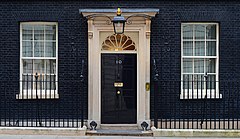British Prime Minister's Office
| Number 10 Downing Street | |
|---|---|
 |
|
 |
|
| General information | |
| Architectural style | Georgian |
| Town or city |
City of Westminster London, SW1 |
| Country | England |
| Coordinates | 51°30′12″N 0°07′40″W / 51.503396°N 0.127640°WCoordinates: 51°30′12″N 0°07′40″W / 51.503396°N 0.127640°W |
| Current tenants | |
| Construction started | 1682 |
| Completed | 1684 |
| Design and construction | |
| Architect | Kenton Couse |
| Website | |
| gov.uk | |
|
Listed Building – Grade I
|
|
| Reference no. | 1210759 |
10 Downing Street, colloquially known in the United Kingdom as Number 10, is the headquarters of Government of the United Kingdom and the official residence and office of the First Lord of the Treasury, a post which, for much of the 18th and 19th centuries and invariably since 1905, has been held by the Prime Minister.
Situated in Downing Street in the City of Westminster, London, Number 10 is over 300 years old and contains approximately 100 rooms. A private residence occupies the third floor and there is a kitchen in the basement. The other floors contain offices and conference, reception, sitting and dining rooms where the Prime Minister works, and where government ministers, national leaders and foreign dignitaries are met and entertained. At the rear is an interior courtyard and a terrace overlooking a garden of 0.5 acres (2,000 m2). Adjacent to St James's Park, Number 10 is near Buckingham Palace, the London residence of the British monarch, and the Palace of Westminster, the meeting place of both houses of parliament.
Originally three houses, Number 10 was offered to Sir Robert Walpole by King George II in 1732. Walpole accepted on the condition that the gift was to the office of First Lord of the Treasury rather than to him personally. Walpole commissioned William Kent to join the three houses and it is this larger house that is known as Number 10 Downing Street.
The arrangement was not an immediate success. Despite its size and convenient location near to Parliament, few early Prime Ministers lived there. Costly to maintain, neglected, and run-down, Number 10 was close to being demolished several times but the property survived and became linked with many statesmen and events in British history. In 1985 Margaret Thatcher said Number 10 had become "one of the most precious jewels in the national heritage".
...
Wikipedia
